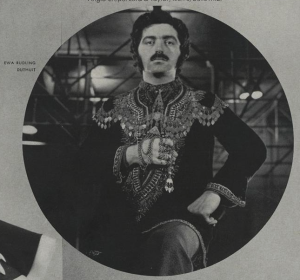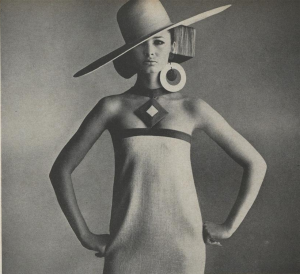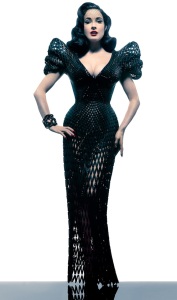
Happy birthday to Paco Rabanne who was born on this day in 1934; a man who made waves, or should we say, links— that is— between fashion and architecture during the 1960s!
Formally trained as an architect, Rabanne got his first taste for fashion while he was in school, drawing fashion sketches for Dior and Givenchy as well as shoe sketches for Charles Jourdan.[1] Rabanne, a Spaniard from the Basque region, made his own mark on fashion when he launched a line of colorful plastic accessories in geometric shapes or spring 1965 that the fashion press overwhelmingly praised.[2] Not only were they plastic, they were large and eye-catching—layered square, circle, and rectangular earrings; circular arm cuffs; and even vinyl visors in shocking colors like chartreuse or a vibrant orange. For resort and summer 1966, Rabanne expanded his line of accessories to include jewelry for feet and ankles—toe rings that connected to an anklet with a chevron pattern or a blooming flower— all made from beautiful, malleable plastic. Rabanne’s plastic accessories flaunted their immediacy, affordability, and expendability—which became the new set of virtues upheld by the reigning 1960s youth culture. They flouted the stuffiness of the establishment, the haute couture, and the legions of women they dressed. Rabanne’s accessories were meant to be worn once, twice, maybe even three times, but just until the wearer grew tired of it, and out it went and onto the next! They appeared in almost every fashion editorial in Vogue that year.


For spring/summer 1966 Rabanne translated his approach to plastic into a collection of dresses that he presented in Paris and later in New York at Lord & Taylor’s Fantasia boutique. Various geometric shapes like diamonds, rectangles, or circles were crafted from thin sheets of Rhodoid that were then linked together to form futuristic looking dresses that resembled plates of armor. The dresses worked with, not against, the limitations of the material and their silhouettes echoed the fashions of the time such as a mini-skirted jumper or a fishtail evening dress. Alterations were made not with needle and thread, but with pliers. Vogue called it a “sensational collection of modern clothes” while WWD announced that New Yorkers were “bowled over by his outerspace dresses.”[3] Women from in fashion capitals all over the world preferred his short dresses that “makes all the noise” to long evening dress that were outdated and about as “non-groovy” as it gets.[4]


Rather than fall victim to his own successes, Rabanne explored other mediums like leather and ostrich feathers for fall/winter 1966. Rabanne’s designs at times played up rather than diminished their ability to curtail costs, like an ostrich feather coat, which according to Vogue, was “marvellously ingeniously made of strips of thick plastic tape, between which feathers are glued.”[5] At others, he lavishly deconstructed white mink only to reassemble it together with silver links to create a geometric patterned coat. Rabanne rebuked the traditions of the haute couture like staging collections within the house’s atelier, and instead, selected Iris Clert, “the most avant of avant garde galleries,” to show his new collection. His designs were set against corresponding paintings of modern artists such as Walter De Maria or Lucio Fontana, equating them at least aesthetically, to art. Rabanne embraced all aspects of modernity, which carried over to his boutique, which opened on 33 rue Bergère in Paris in October, 1966. The interior featured black walls and carpets with, what else, black plastic furniture while steel scaffolding outlined the walls and ceilings. Eventually, fashion, ever the elusive entity moved on and the styles that had dominated by Rabanne and his peers during height of the 1960s Youthquake quickly fell out of favor by the next decade.


Although the Paco Rabanne house continues today, it no longer leads the vanguard in fashion, but methodically churns out derivative work of its eponymous designer. Rabanne was an innovator who challenged the very notion of a textile and his influences are still felt today particularly in the realm of 3D printing. Although today’s 3D printed dresses, most notably by Dutch designer Iris van Herpen, Michael Schmidt and Francis Bitonti’s gown for Dita Von Teese, and the Kinematics Dress by Nervous System, are much more sophisticated in their design and structure, they are still inevitably restricted by the realities of the material— “rigid, hard plastic.”[6] Printed in variations of flowing mesh, all three of the aforementioned dresses are ultimately adaptations of Rabanne’s ingenious, chain-linked designs from the 1960s. Issey Miyake’s Bao Bao line of geometric bags and pouches that resemble tangrams also seem to reference Rabanne’s fluid, pieced designs. Rabanne will always be remembered for his experimentation with and application of unconventional, industrial materials like plastic, neon and metal towards fashion. His designs overturned and redefined the fashion system of the mid-1960s— staunchly declaring that new was in and old was out; youthfulness was revered and elegance was dead. Long live Paco Rabanne!







Notes:
[1] Claude De Leusse, “They’re Dingues:” (Dinge means mad, wild,” WWD, October 15, 1965, 14.
[2] Ibid.
[3] “The Plastic World of Paco Rabanne,” WWD, March 29, 1966, 8, and “Vogue’s Own Boutique,” Vogue, April 1, 1966, 115.
[4] Carol Bjorkman, “Carol,” WWD, April 29, 1966, 7.
[5] “Vogue’s Own Boutique,” Vogue, September 15, 1966, 173.
[6] “Kinematics Dress by Nervous System- 3D Printed by Shapeways,” Youtube Video, https://www.youtube.com/watch?v=wdRswasftfI
I have noticed you don’t monetize your page, don’t waste your traffic, you can earn extra bucks every month.
You can use the best adsense alternative
for any type of website (they approve all websites), for more
details simply search in gooogle: boorfe’s tips monetize your
website
LikeLike
[…] https://theartofdress.org/2015/02/18/born-on-this-day-in-fashion-history-paco-rabanne/ […]
LikeLike
am a realy challenged as an uprising fashion designer..Good job you really did.
LikeLike
Great post !!
LikeLike